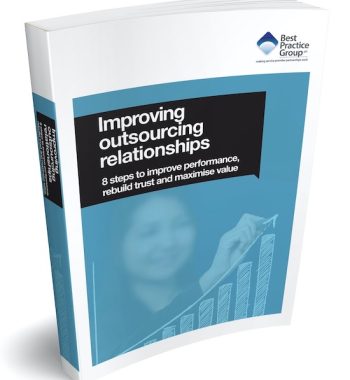 The adverse financial ramifications of large PFI contracts that were negotiated in healthier economic times are only now becoming clear to many public sector organisations across the UK. Such agreements were entered into with the best of intentions and were usually fit for purpose at the time, but the dramatic shift in finances available to the public sector has changed the financial viability of such partnerships drastically.
The adverse financial ramifications of large PFI contracts that were negotiated in healthier economic times are only now becoming clear to many public sector organisations across the UK. Such agreements were entered into with the best of intentions and were usually fit for purpose at the time, but the dramatic shift in finances available to the public sector has changed the financial viability of such partnerships drastically.
If you have a non-performing contract, deciding to renegotiate it at a given point is a complicated affair fraught with potential pitfalls. But in fairness, almost everyone expects it. Interestingly, negotiations are only made more troublesome if the provider is actually performing well and meeting outcomes. But when you throw multiple stakeholders into the mix too, a positive resolution can seem all but impossible.
However, it is possible to cut costs in a successful PFI partnership. It certainly isn’t easy, but with the correct approach and buy-in from key stakeholders, one can reach an agreement that benefits all parties in the long term.
Step 1: Be Clear About What You Want To Achieve
Before you do anything you need to gain a better grasp of exactly what you hope to achieve through renegotiation. “Cutting costs” is all well and good, but you need to consider how costs will be cut.
There are two main considerations:
- Do you need to cut or re-shape (re-scope) services?
- Will you also be looking for your partner to reduce their profit margin?
Renegotiating a contract under such circumstances is a delicate enough process as it is, so it is important that you equip yourself with an understanding of your intended outcomes before you approach your partner.
Your success in reaching an ‘in principle’ agreement with your partner will largely be defined by who you talk to within the organisation. Stakeholders, at the operational level, are typically incentivised to maximise profit and, as such, may not be as open minded and collaborative to talk to about reducing output and shrinking margins. Ideally, you need to be dealing with stakeholders at the executive level — people who, in our own experience, if positioned correctly, are more likely to take an objective view based upon greater revenue streams in the longer term, along with relationship building and trust for mutual gain.
The key here is to identify whether you are operating as a true partnership/alliance, or buyer/supplier relationship. If it’s a buyer/supplier relationship, your ‘partner’ is likely to take a short-term and solely profit-driven approach to the contract; you may find that renegotiation or re-shaping is extremely challenging in these circumstances. If, on the other hand, you do have a true partnership/alliance operating model, your partner will understand your financial challenges; they are far more likely to work with you on ‘outside-of-the-box’ thinking that can appeal to both their and your sense of partnership and moral obligation to work together, thus realising that a favourable outcome is possible.
Ultimately, a wise provider partner will understand the long term benefits of working in true partnership with a public sector organisation, be it a local authority, NHS trust, police force or the like. But this works both ways. In a number of partnerships we see providers bend over backwards to accommodate the financial challenges of their public sector partners, but is that reciprocated by the partner? Sometimes it is, other times not so.
By way of example, in some local authorities we have seen them complain about the lack of ‘partnership’ working from their provider. Often, the provider has in fact tried various initiatives and ideas to help the authority, but these have either been spurned, or where opportunities have arisen for the local authority executive to open a door for a good provider, they have failed to do so. Not for any other reason, than often the executive just doesn’t think about it. Senior executives of any authority that experience a positive relationship with a provider have a moral obligation to recommend that provider both internally and to other councils and peers. In this way, if the executives in councils actively help their providers open new doors, whether it is to other private sector or public sector organisations, this helps build much greater trust and the provider will seek active ways to help their organisation in their hour of need.
Step 2: Quantify Your Outcomes
Any outcome you agree in principle with your partner regarding re-shaping/re-scoping services must be quantifiable. This is partly about clear definition and partly about enabling the partner’s lender(s) to calculate risk and outcome. One must consider that the lender entered into a contract with your partner on the basis of a predictable outcome over the course of a period of time. If you both approach the lender(s) with only a vague suggestion as to your intended outcomes then you’re likely to spook them, rather than encourage them to enter into discussions.
This is the stage at which you must approach the situation from the perspective of the lender(s). Their view is usually one-dimensional — any decision they make will be based upon risk to their future income stream. If you can provide a solution that is broadly favourable for the lender(s) and does not affect their perception of inherent risk too much, the chances of reaching an agreement will be greatly increased.
Before you go any further in the process, you must ensure that you have buy-in from all stakeholders within your organisation. For local government, this applies especially to Councillors — if they are kept out of the loop and/or do not agree with your proposed course of action, their public reaction may provide exactly the kind of headache you could do without. In the same way that you work with your provider in true partnership to reach the best possible outcome for all parties, you should do the same with Councillor stakeholders within the council.
Step 3: Approach Your Provider’s Lender(s) as a Partnership
It is vital that you and your partner(s) put on a united front in approaching the lender(s). You must work as a partnership in the true sense of the word.
One of the key determinants is your own preparation before you and your partner approach the lender(s) — if the lender(s) feels that either one of you lacks faith or is not clear in your own proposals, then they are extremely unlikely to accept it. Furthermore, building trust through the process of negotiation is absolutely vital. We dedicated an entire chapter of our recent white paper on improving performance, rebuilding trust and maximising value to this topic (read from page 18). You may also wish to read an article we published earlier this year on how to renegotiate contracts.
Although it can be all too easy to view lender(s) as immovable objects, the representatives you deal with probably will appreciate the position of public sector organisations in terms of drastic cost cutting requirements and legacy contracts that no longer fit with new budgets. If you work for a local authority, the last thing the lender(s) want to do is burn bridges — collectively speaking local authorities represent an enormous chunk of business for them, so given their understanding of this market, they know change is on the cards in any event.
So don’t view either your PFI partner or its lender(s) as the enemy — generally speaking, they are inclined to work with you if at all possible. While they’re not going to gift you anything — you still need to demonstrate that your revised contract is not going to increase their exposure to risk and doesn’t stray too far from the original agreement. They are prepared to talk if you demonstrate yourself to be clear about win-win benefits from renegotiation. Think “alternative certainty” rather than “renegotiation”.
An Involved Process
I don’t want to beat around the bush — there is nothing simple about the process of renegotiating a well-performing PFI contract. However, a healthy dose of common sense (including pro-actively helping the provider open new doors so it can address new opportunities) and a willingness to work in true partnership with your provider will take them and you a very long way towards achieving a positive outcome.
And, at the end of the day, a positive outcome is what you both want. While you may not achieve all of your intended outcomes, any net reduction in end-to-end costs in return for ‘good-enough’ outcomes puts you in a stronger position than you were previously. If you plan carefully, clearly define quantifiable outcomes and present your case to the lender(s) in true partnership with your provider, you have every chance of succeeding.
If you would like to know more about the details of PFI renegotiations or strategic vendor contract negotiations that help build trust and maximise value for both you and your partner, please read our PFI Operational Contracts Support page or do not hesitate to contact us for an informal chat to gain an insight into what other public sector organisations have done in similar circumstances.
Photo Credit: Joffley

